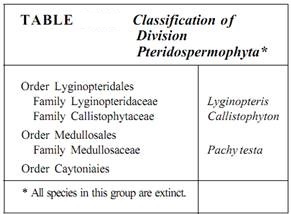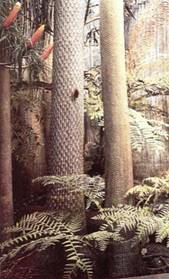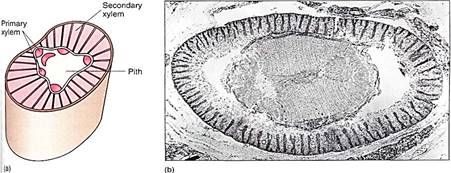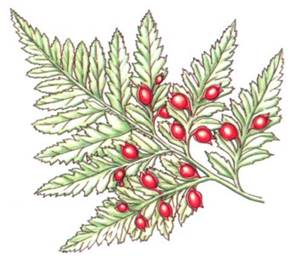
Division Pteridospermophyta: Seed Ferns
 المؤلف:
AN INTRODUCTION TO PLANT BIOLOGY-1998
المؤلف:
AN INTRODUCTION TO PLANT BIOLOGY-1998
 المصدر:
JAMES D. MAUSETH
المصدر:
JAMES D. MAUSETH
 الجزء والصفحة:
الجزء والصفحة:
 24-11-2016
24-11-2016
 2509
2509
Division Pteridospermophyta: Seed Ferns
Progymnosperms gave rise to another line of gymnospermous plants in addition to the conifers: the cycadophytes . These are classified as three divisions: Pteridospermophyta (seed ferns, all extinct; Table ), Cycadophyta (cycads, extant), and Q- cadeoidophyta (cycadeoids, all extinct).
The earliest seed ferns appeared in the Upper Devonian Period; they were wiry plants with fernlike foliage that bore seeds instead of sori on their leaves. Many seed ferns resembled modern tree ferns, but others were vines that either climbed on or scrambled over other plants (Fig. 1).
Pteridosperms are thought to have evolved from the Aneurophytales because the earliest seed ferns, such as Stenomyelon, had a three-ribbed protostele as in the aneurophytes Triloboxylon and Aneurophyton. In later species of Stenomyelon, Calamopitys, and Lyginoptens, most central cells of the stem differentiated as parenchyma, not tracheids (Fig. 2a). They had a ring of vascular bundles surrounding a pith; such an arrangement also occurs in the stems of all gymnosperms and angiosperms. Seed ferns had a vascular cambium that was long-lived and produced both xylem and phloem; this too is similar to gymnosperms and angiosperms. Although their wood was basically similar to that of their progymnosperm ancestors, there were interesting differences. Tracheids were much longer and wide enough that several rows of circular bordered pits could occur on each radial wall; conifer tracheids are so narrow that only one or two rows can fit on each radial wall. Rays in Pteridosperms wood were many cells wide, not just one cell wide, and they were very tall, being large wedges of parenchyma. This wood is much softer and less dense than the wood of conifers and progymnosperms. This type of parenchymatous wood also occurs in cycads and cycadeoids. Around the stem was a thick cortex that contained distinctive radial plates of sclerenchyma just below the epidermis (Fig. 2b). The inner cortex contained secretory ducts. In older plants, a cork cambium and bark formed exterior to the secondary phloem; the cortex was shed with the first bark.


FIGURE 1 :Reconstruction of a swamp-forest during the Carboniferous Period. The large trees are related to Lepidodendron, (Sigillaria rugosa on the left, S. saulli on the right), and the smaller fernlike plants are seed ferns (Neuropteris decipiens), not true ferns. Note the seeds at the ends of some fronds. (75400c Field Museum of Natural History, Chicago).

FIGURE 2:(a) The vascular system of seed plants (a siphonostele) evolved from a protostele as some of the central cells failed to differentiate into tracheids, maturing as parenchyma instead. This is a diagram of Calamopitys americana, which represents a stage in which most cells still differentiate into tracheids, but a few form parenchyma (pink region). Normal primary xylem still forms on the edges (red), and then a cambium arises and produces secondary xylem to the exterior (brown area), (b) A transverse section of Schopfiastrum stem, showing the beginning of a pith, parenchymatous wood, and the distinctive cortex with plates of sclerenchyma (X 10). (Courtesy of B. M. Stidd and T. L. Phillips, Western Illinois University).
The leaves of seed ferns were similar to those of true ferns in overall organization— large, compound, and planar. Unlike ferns, however, the foliage leaves of seed ferns bore seeds, not sori (Fig. 3). Within the seed fern ovule the megasporangium (nucellus) was large and vascularized, with bundles of vascular tissue running into and through it. The integument was attached to the megasporangium only at the base and was vascularized. Seeds could be extremely large, up to 11 cm long and 6 cm in diameter in the now extinct Pachytesta incrassata; at maturity they had a thick three-layered seed coat.

FIGURE 3: Seed ferns, such as this Emplectopteris, bore seeds along their leaves, not in cones. Otherwise, seed fern leaves were remarkably analogous (not homologous) to the leaves of true ferns in terms of venation and tissue structure.
 الاكثر قراءة في البذور (مغطاة البذور - عاريات البذور)
الاكثر قراءة في البذور (مغطاة البذور - عاريات البذور)
 اخر الاخبار
اخر الاخبار
اخبار العتبة العباسية المقدسة


